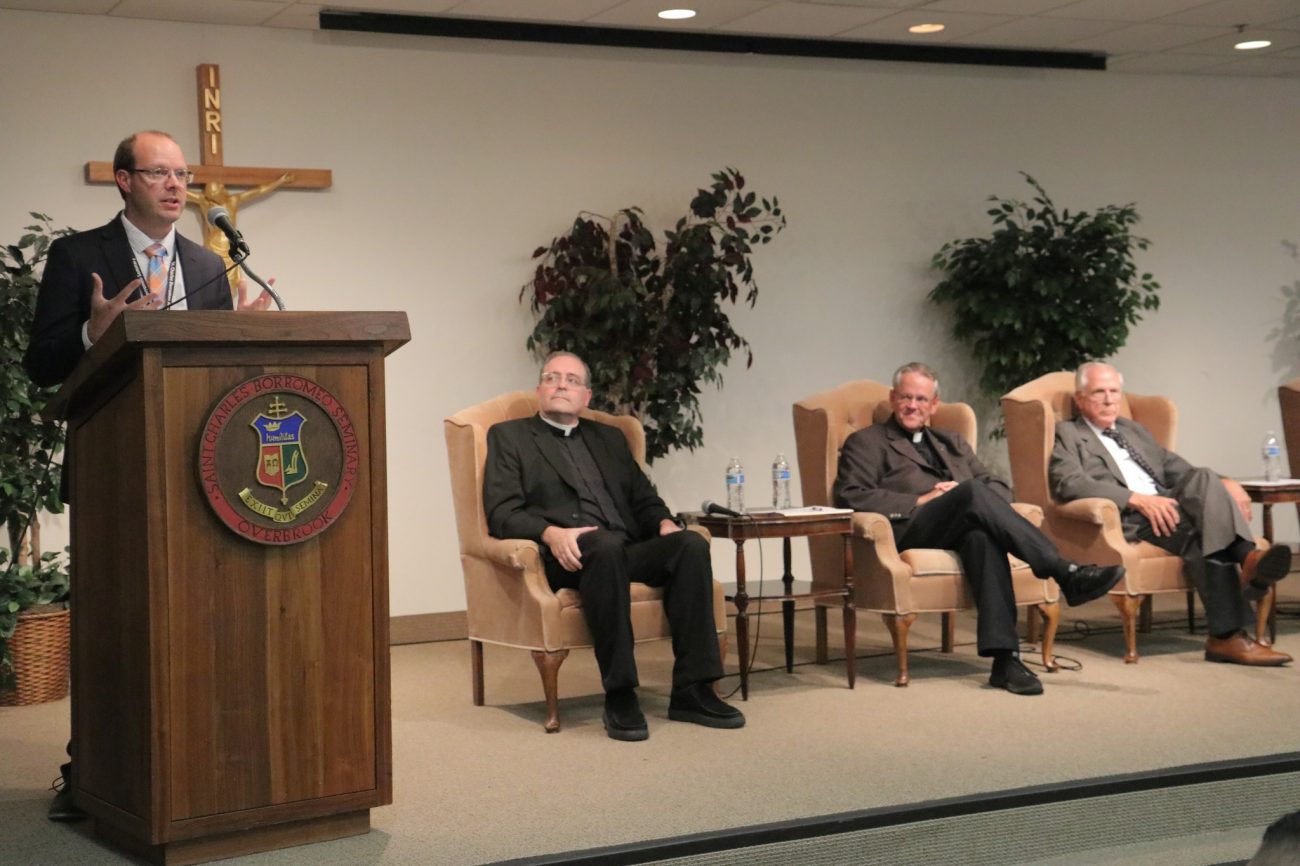From its beginning in 2021, the church’s Synod on Synodality has raised a question: where is this worldwide process of listening to the people of God, especially those on the margins, going?
Panelists at St. Charles Borromeo Seminary probed the question Tuesday night, Aug. 29 in the Cardinal’s Forum with the theme, “Synodality … a style, a mentality, a spirituality, a pastoral model.”
Three panelists represented the endowed chairs of the seminary in areas including moral theology, social communications and sacred music. Each brought perspectives that mirrored tensions and hopes for a renewed missionary spirit in the church that the synod process has revealed.
Their five-minute talks, followed by a question-and-answer session with seminarians in attendance, reflected themes revealed in the comments expressed by people participating in the synod’s listening sessions in the Philadelphia Archdiocese and across North America.
Pope Francis will be joined by bishops, clergy and lay people in October in Rome at the Synod of Bishops to discuss the findings of the worldwide consultations.
Dr. John Haas, the seminary’s Cardinal Krol Chair of Moral Theology, began with a blistering critique of the global synod’s working document (Instrumentum Laboris). Referring to the document as “tendentious, tedious and painfully vague,” he said it uses a circular argument to define the synod as synodality.
Haas noted that the working document says the “synodal church is a listening church,” but he said he found the reference “to be most troubling. I cannot help wondering to whom is the church listening, and to what end, and what is being said?”
The document pointed out that the church traditionally has assisted people in need, such as refugees or victims of disaster, through its charitable agencies. But the document, he said, “makes an unfortunate shift” from a call to assist those in need to “a call to embrace even those who may have excluded themselves by their own actions.”
The document lists those to be included as remarried divorcees, those in polygamous marriages, and LGBTQ+ people.
Haas said he was “dismayed” to read in a church document the acronym referring to people identifying themselves as lesbian, gay, bisexual, transexual, queer and “whatever other sexual aberration individuals might seek to engage in.”
He called for a reliance on divine revelation in order to interpret the reflections gathered in the synod process and to deal with issues such as the exclusion of persons, clericalism and ambiguity in teaching.
Haas also bemoaned the lack of a stated end or goal for the synod. “The end makes any act possible,” he said. “What is the end of the listening and the journeying?”
Oblate Father Thomas Dailey, the Cardinal Foley Chair of Homiletics and Social Communications, in his talk and in answer to questions following, suggested there may be no end goal of the synod. The voyage itself, not its destination, may be the will of God for the church at this time.
Father Dailey proposed the image of the Barque of Peter, a 14th-century artwork that depicts the Christian Church as a large boat with St. Peter at the helm, its deck crowded with disciples from every walk of life, rowing together on their earthly journey toward Christ, impelled by the power of the wind, symbolizing the Holy Spirit.
The Church “requires that we be on board, that we learn to talk with and listen to each other, so that we can navigate together according to God’s way and reach our final destination without capsizing. It may be a challenge, but we cannot willingly let anyone fall overboard.”
A diversity of voices has emerged in the church through participation in the synod, but the call to unity remains an ever-present though difficult reality, Father Dailey suggested.
He referred to his religious order’s 17-century founder, St. Francis de Sales, in explaining the tension between diversity of peoples and their unity.
“(In the) divine providence, it is not our differences that define us, but our unity as believers and disciples,” Father Dailey said.
The lesson from St. Francis is that in “unidiversity” – which the saint described as uniqueness along with diversity, diversity along with unity – “lies spiritual beauty,” Father Dailey said.
Because beauty matters, “our challenge and task is to see it and seek it, work together as we row toward it, and learn to appreciate and embrace it, so that we can communicate God’s beauty in our own lives and in our vocations in a synodal Church,” he said.
Dr. Nathan Knutson, the Louise Francesco Chair in Sacred Music, picked up the theme of beauty since he is a specialist in sacred art in the liturgy of the church. He emphasized the missionary thrust of the synod and broadly of the church today.
Principles – meaning church teaching and liturgical practices that have stood the test of time – must be placed ahead of passing cultural preferences if the church is to pass on the faith to succeeding generations.
“Pope Francis has called us to do as missionary disciples of Christ: to look at the church from other viewpoints, to learn, but then to act in truth and to open our hearts toward a heavenly vision rather than simply a worldly one,” Knutson said.
PREVIOUS: Philly Area Catholic High School Teachers Approve a New Contract
NEXT: Julia Rocchi to Helm Workshop on Contemplative Collection of Prayers and Essays




Share this story